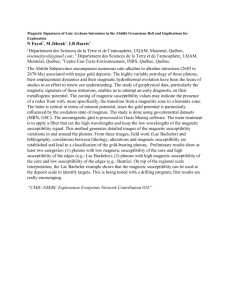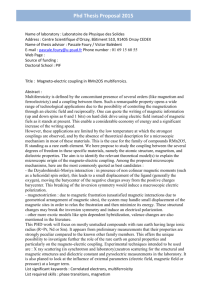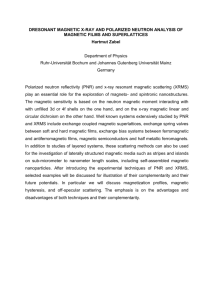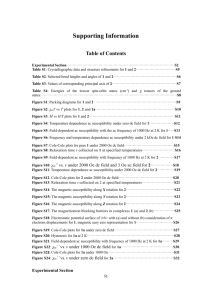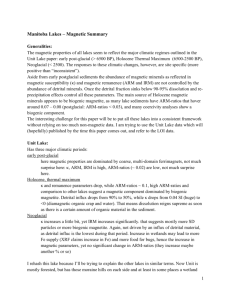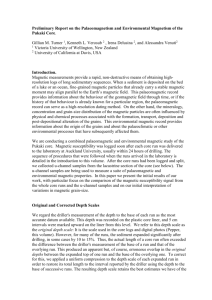Magnetic-susceptibility-as-a-high-correlation-tool
advertisement
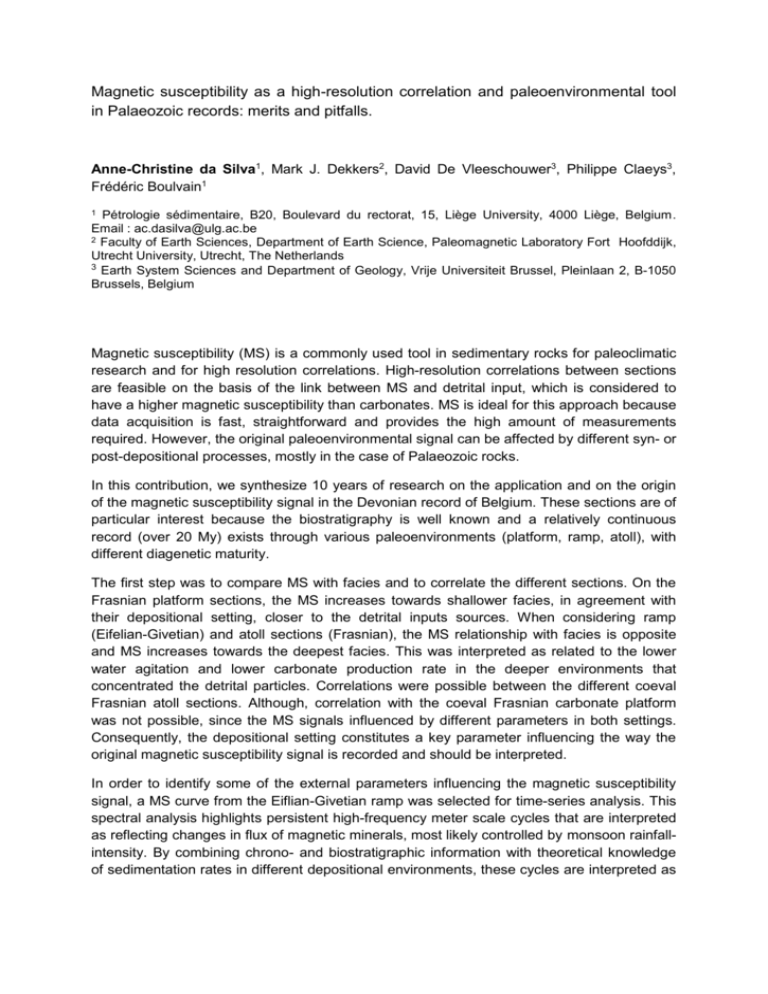
Magnetic susceptibility as a high-resolution correlation and paleoenvironmental tool in Palaeozoic records: merits and pitfalls. Anne-Christine da Silva1, Mark J. Dekkers2, David De Vleeschouwer3, Philippe Claeys3, Frédéric Boulvain1 1 Pétrologie sédimentaire, B20, Boulevard du rectorat, 15, Liège University, 4000 Liège, Belgium. Email : ac.dasilva@ulg.ac.be 2 Faculty of Earth Sciences, Department of Earth Science, Paleomagnetic Laboratory Fort Hoofddijk, Utrecht University, Utrecht, The Netherlands 3 Earth System Sciences and Department of Geology, Vrije Universiteit Brussel, Pleinlaan 2, B-1050 Brussels, Belgium Magnetic susceptibility (MS) is a commonly used tool in sedimentary rocks for paleoclimatic research and for high resolution correlations. High-resolution correlations between sections are feasible on the basis of the link between MS and detrital input, which is considered to have a higher magnetic susceptibility than carbonates. MS is ideal for this approach because data acquisition is fast, straightforward and provides the high amount of measurements required. However, the original paleoenvironmental signal can be affected by different syn- or post-depositional processes, mostly in the case of Palaeozoic rocks. In this contribution, we synthesize 10 years of research on the application and on the origin of the magnetic susceptibility signal in the Devonian record of Belgium. These sections are of particular interest because the biostratigraphy is well known and a relatively continuous record (over 20 My) exists through various paleoenvironments (platform, ramp, atoll), with different diagenetic maturity. The first step was to compare MS with facies and to correlate the different sections. On the Frasnian platform sections, the MS increases towards shallower facies, in agreement with their depositional setting, closer to the detrital inputs sources. When considering ramp (Eifelian-Givetian) and atoll sections (Frasnian), the MS relationship with facies is opposite and MS increases towards the deepest facies. This was interpreted as related to the lower water agitation and lower carbonate production rate in the deeper environments that concentrated the detrital particles. Correlations were possible between the different coeval Frasnian atoll sections. Although, correlation with the coeval Frasnian carbonate platform was not possible, since the MS signals influenced by different parameters in both settings. Consequently, the depositional setting constitutes a key parameter influencing the way the original magnetic susceptibility signal is recorded and should be interpreted. In order to identify some of the external parameters influencing the magnetic susceptibility signal, a MS curve from the Eiflian-Givetian ramp was selected for time-series analysis. This spectral analysis highlights persistent high-frequency meter scale cycles that are interpreted as reflecting changes in flux of magnetic minerals, most likely controlled by monsoon rainfallintensity. By combining chrono- and biostratigraphic information with theoretical knowledge of sedimentation rates in different depositional environments, these cycles are interpreted as astronomically driven (precession-dominated). In this case, the magnetic susceptibility signal reflects astronomical forcing, through variations in detrital inputs. To understand the nature and origin of the magnetic susceptibility signal, it is crucial to identify the magnetic minerals that are carrying this MS signal. Geochemistry and magnetic analyses (hysteresis and acquisition curves of the Isothermal Remanent Magnetic Saturation IRM) were performed on three sections (two Frasnian platform sections and one Eifelian Givetian platform section). Magnetic parameters show that the MS signal is mostly influenced by fine-small grained magnetites which were formed during a Variscan remagnetization event. This remagnetization occurred during the Carboniferous and is interpreted to be related to the smectite-illite transformation (releasing the iron for the magnetite formation). In two sections, the Eifelian Givetian platform section and one of the Frasnian platform, a strong link exists between the MS signal and TiO2, Al2O3 and Zr concentrations, ,which are detrital proxies. This shows that despite the remagnetization, the MS signal is still related to detrital input, indicating that the newly formed magnetite probably remained associated with the original clay minerals, leading to a globally increased signal still reflecting the primary trends. In one section (Frasnian platform), there is no strong link between MS signal and detrital proxies, indicating that in this case the MS signal was affected by the remagnetization event (possibly in relation with fluid circulation). In conclusion, MS appears as a convolved signal, related on one hand to primary parameters such as the amount of detrital inputs and this amount can be by influenced by orbital cyclicities. On the other hand, depositional parameters such as water agitation and carbonate production can also influence the way MS cycles are recorded. Furthermore, the diagenesis can also have a strong impact on the final signal. This clearly highlights the need to use magnetic susceptibility in conjunction with other techniques (comparison with other paleoenvironmental proxies or magnetic or geochemical analysis). .


